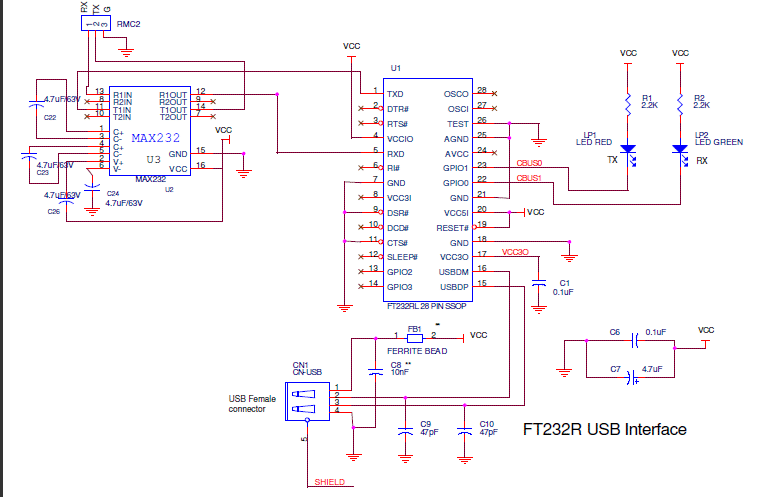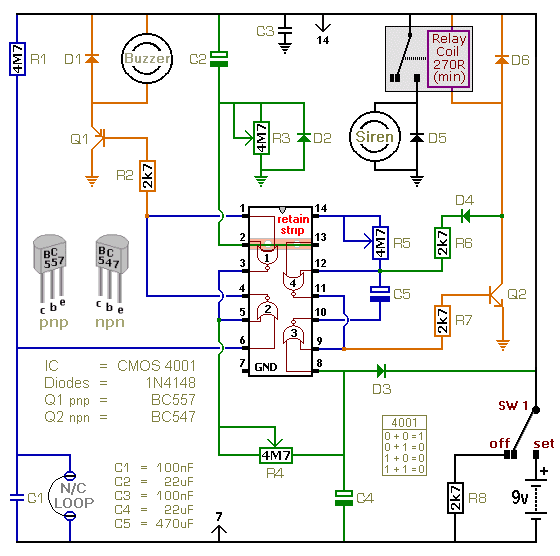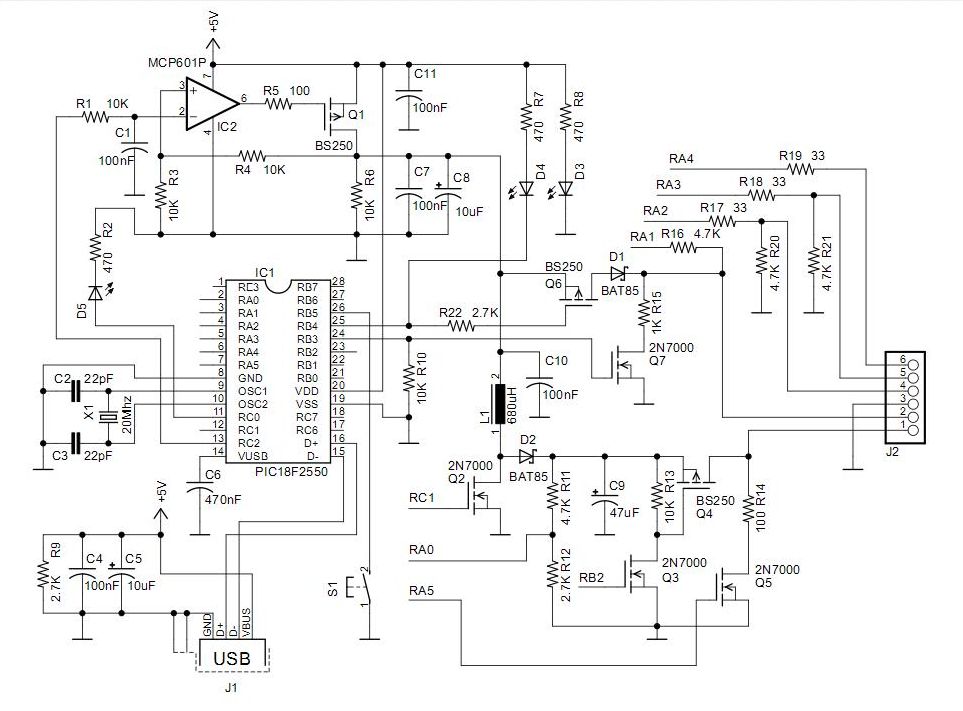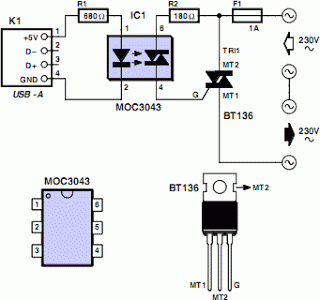
F232 is USB powered

The F232 device is powered via USB, but it requires a level translator at its output. The transmit (Tx) signal from the F232 must be converted to RS232 levels, as the receiving side has a maximum voltage requirement. The receive pin can be easily interfaced using an opto-isolator, but the transmit pin necessitates a power supply that aligns with RS232 levels. In some instances, a higher supply voltage can be derived from the remote RS232 chip, provided there is control over the remote maximum pin. The circuit has been modified to substitute the RS232 chip with a MAX232 component on a board produced by FTDI. FTDI provides the circuit and Gerber files on their website; however, an alternative layout created by another individual was utilized instead of their Gerber files.
The F232 is a USB interface device that facilitates communication with RS232 systems. To ensure proper signal levels between the F232 and the RS232 interface, a level translator is essential. The F232 outputs a digital signal compatible with USB standards, which typically operates at lower voltage levels than those required by RS232. The MAX232 is a commonly used integrated circuit that converts TTL (Transistor-Transistor Logic) levels to RS232 voltage levels, allowing for effective communication between the two systems.
In this configuration, the Tx pin of the F232 is connected to the input of the MAX232, which then translates the signal to the appropriate RS232 levels. The design also incorporates a power supply arrangement that ensures the MAX232 receives sufficient voltage to operate correctly. This is particularly crucial because the RS232 standard requires higher voltage levels for signal integrity over longer distances.
For the receive (Rx) side, the use of an opto-isolator can provide electrical isolation between the F232 and the RS232 device, protecting both devices from potential voltage spikes or ground loop issues. The opto-isolator converts the RS232 signal back to TTL levels that the F232 can interpret.
The modification to replace the original RS232 chip with the MAX232 enhances the reliability and performance of the circuit. The MAX232 is favored for its ability to operate with a low supply voltage while still conforming to RS232 standards. The circuit layout, while not based on FTDI’s provided Gerber files, maintains compliance with necessary electrical specifications, ensuring that the custom design functions effectively within the intended application.
Overall, the integration of the F232 with the MAX232 level translator creates a robust solution for interfacing USB devices with RS232 systems, facilitating seamless communication and data transfer between disparate technologies.F232 is USB powered, but you need to have a level translator at the output of F232. Tx of f232 has to be converted to RS232 levels, since the other side has a max. Receive pin can be easily opto-ed. But the transmit pin, need to have a supply in line with RS232 levels. Sometimes we d it by making a higher supply from the remote RS232 chip - a comm on method, if you are in control of the remote max pin. Here is the circuit. I modified the circuit to replace rs232 chip with MAX232 to the board sold by FTDI guys. FTDI has got circuit + gerbers in their site. I did not use their gerbers. Got a layout made by someone. 🔗 External reference
The F232 is a USB interface device that facilitates communication with RS232 systems. To ensure proper signal levels between the F232 and the RS232 interface, a level translator is essential. The F232 outputs a digital signal compatible with USB standards, which typically operates at lower voltage levels than those required by RS232. The MAX232 is a commonly used integrated circuit that converts TTL (Transistor-Transistor Logic) levels to RS232 voltage levels, allowing for effective communication between the two systems.
In this configuration, the Tx pin of the F232 is connected to the input of the MAX232, which then translates the signal to the appropriate RS232 levels. The design also incorporates a power supply arrangement that ensures the MAX232 receives sufficient voltage to operate correctly. This is particularly crucial because the RS232 standard requires higher voltage levels for signal integrity over longer distances.
For the receive (Rx) side, the use of an opto-isolator can provide electrical isolation between the F232 and the RS232 device, protecting both devices from potential voltage spikes or ground loop issues. The opto-isolator converts the RS232 signal back to TTL levels that the F232 can interpret.
The modification to replace the original RS232 chip with the MAX232 enhances the reliability and performance of the circuit. The MAX232 is favored for its ability to operate with a low supply voltage while still conforming to RS232 standards. The circuit layout, while not based on FTDI’s provided Gerber files, maintains compliance with necessary electrical specifications, ensuring that the custom design functions effectively within the intended application.
Overall, the integration of the F232 with the MAX232 level translator creates a robust solution for interfacing USB devices with RS232 systems, facilitating seamless communication and data transfer between disparate technologies.F232 is USB powered, but you need to have a level translator at the output of F232. Tx of f232 has to be converted to RS232 levels, since the other side has a max. Receive pin can be easily opto-ed. But the transmit pin, need to have a supply in line with RS232 levels. Sometimes we d it by making a higher supply from the remote RS232 chip - a comm on method, if you are in control of the remote max pin. Here is the circuit. I modified the circuit to replace rs232 chip with MAX232 to the board sold by FTDI guys. FTDI has got circuit + gerbers in their site. I did not use their gerbers. Got a layout made by someone. 🔗 External reference





